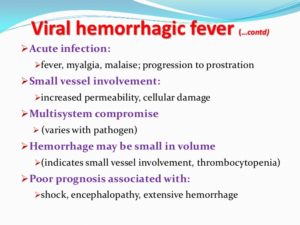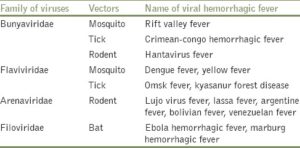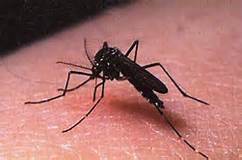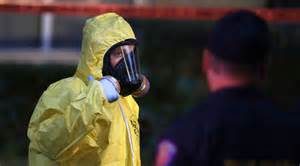Hemorrhagic fevers are caused by a variety of infections from viral agents that originate in animals and insects, including rodents and mosquitoes, according to the Mayo Clinic. The type of virus determines how the infection spreads, such as tick bites or contact with contaminated rat feces.
Examples of viral hemorrhagic fevers include dengue, yellow fever and ebola, the CDC Special Pathogens Branch states. VHFs are caused by four families of viruses that all rely on specific animal or insect hosts, known as natural reservoirs and vectors, and they only occur in the geographic regions of their host species. While VHFs never originate in humans, some variants can spread from person to person once contracted.
According to WebMD, symptoms of dengue fever include a sudden, high fever, severe headaches, joint and muscle pain, pain behind the eyes, nausea, vomiting, skin rash, and mild bleeding. As of 2014, there is no treatment for dengue fever. However, WebMD recommends taking acetaminophen to reduce pain and fever, drinking plenty of fluids and getting plenty of bed rest.
Dengue fever is the result of the transmission of one of four dengue viruses through mosquito bites, according to WebMD. Most of the infections take place in tropical climates, especially areas around southeast China, the Caribbean and Mexico. Most Americans become infected with dengue fever by travelling to places where the disease is present, and infection can be confirmed with a simple blood test.
The first symptoms appear anywhere between four and six days after contracting the virus and usually last around 10 days. Young children or people that have never contracted the disease usually suffer from milder symptoms. However, people that have a weakened immune system or who have been previously infected are at a greater risk of developing complications, including dengue hemorrhagic fever and failure of the circulatory system. WebMD recommends that people who believe that they are infected with dengue fever should get medical attention, especially if they begin to feel worse after the fever has diminished.
Contact with infected bodily fluids and secretions typically causes transmission of VHFs, according to the CDC Special Pathogens Branch. Occasionally, VHFs spread to geographic regions where they don’t occur naturally after an imported host or infected traveler carries the virus. A direct bite usually causes insect-related infections, but humans can also contract viruses from handling livestock infected by insect bites.
Symptoms of VHFs depend on the disease, but they commonly include high fever, muscle and joint aches, dizziness, shock and fatigue, the Mayo Clinic states. In more severe cases, these viruses cause bleeding from the eyes, mouth or ears and internal hemorrhaging under the skin and inside organs.
Patients with viral hemorrhagic fevers usually receive only supportive therapy; there is no other established cure for viral hemorrhagic fevers. However, ribavirin (Rebetol, Copegus) has been effective in treating some individuals with Lassa fever, and treatment with convalescent-phase plasma has been used with success in a few patients — other experimental antiviral agents have also been tried in a few patients.
Prevention and control of hemorrhagic fevers is difficult; except for yellow fever and Argentine hemorrhagic fever, no vaccines have been made commercially available so that prevention efforts are concentrated on avoiding contacts with the host species, vectors, or humans infected with the viruses.
Marburg Virus Disease History, Symptoms, and Treatment
The Ugandan Ministry of Health reported on Oct. 5, 2014, that a health-care worker died of Marburg virus disease (formerly known as Marburg hemorrhagic fever [Marburg HF]) on Sept. 30, 2014. The source of his exposure is not clear. This is of interest since Marburg virus is a close relative of the Ebola virus, and both produce clinical signs and symptoms that are often indistinguishable.
Viral hemorrhagic fever (VHF) facts*
*Viral hemorrhagic fever facts by Charles Patrick Davis, MD, PhD
- Viral hemorrhagic fevers are group of illnesses caused by viruses that cause vascular damage that result in symptomatic bleeding (hemorrhage).
- Hemorrhagic fever viruses are mainly zoonotic diseases caused by viruses that usually reside in an animal or arthropod hosts that may serve as vectors.
- Viral hemorrhagic fevers are usually seen associated with only one particular of species and consequently are usually contained in geographically restricted areas; however, if the virus is introduced accidentally to humans it becomes widespread (for example, the current Ebola outbreak).
- Hemorrhagic fever viruses are usually transmitted among animal or arthropod hosts; however, the viruses carried in these animal or arthropods can be transmitted to humans when humans come in contact with the urine, feces, saliva, or other bodily fluids of infected animals or arthropods, including if the animal is killed and eaten. In some instances, once the viruses infect humans, person-to-person transmission can occur when an uninfected person comes in contact with bodily fluids or (with some viruses) a bite by an arthropod vector.
- Symptoms of viral hemorrhagic fever include fatigue, fever, weakness, dizziness, and muscle aches; patients with more severe infections show bleeding under the skin, internal organs, or even from bodily orifices like the mouth, eyes, or ears. Some patients develop severe diarrhea that may also be bloody, and severely ill patients present with shock, delirium, seizures, kidney failure, and coma that often ends in death.
- Patients with viral hemorrhagic fevers usually receive only supportive therapy; there is no other established cure for viral hemorrhagic fevers. However, ribavirin (Rebetol, Copegus) has been effective in treating some individuals with Lassa fever, and treatment with convalescent-phase plasma has been used with success in a few patients — other experimental antiviral agents have also been tried in a few patients.
- Prevention and control of hemorrhagic fevers is difficult; except for yellow fever and Argentine hemorrhagic fever, no vaccines have been made commercially available so that prevention efforts are concentrated on avoiding contacts with the host species, vectors, or humans infected with the viruses.
- Scientists and researchers are addressing the threat of viral hemorrhagic fevers to humans by attempting to develop immunological, molecular, and containment methods to prevent these hemorrhagic fevers.
What are viral hemorrhagic fevers?
Viral hemorrhagic fevers (VHFs) refer to a group of illnesses that are caused by several distinct families of viruses. In general, the term “viral hemorrhagic fever” is used to describe a severe multisystem syndrome (multisystem in that multiple organ systems in the body are affected). Characteristically, the overall vascular system is damaged, and the body’s ability to regulate itself is impaired. These symptoms are often accompanied by hemorrhage (bleeding); however, the bleeding is itself rarely life-threatening. While some types of hemorrhagic fever viruses can cause relatively mild illnesses, many of these viruses cause severe, life-threatening disease.
The Special Pathogens Branch (SPB) primarily works with hemorrhagic fever viruses that are classified as biosafety level four (BSL-4) pathogens. A list of these viruses appears in the SPB disease information index. The Division of Vector-Borne Infectious Diseases, also in the National Center for Infectious Diseases, works with the non-BSL-4 viruses that cause two other hemorrhagic fevers, dengue hemorrhagic fever and yellow fever.
How are hemorrhagic fever viruses grouped?
VHFs are caused by viruses of four distinct families: arenaviruses, filoviruses, bunyaviruses, and flaviviruses. Each of these families share a number of features:
- They are all RNA viruses, and all are covered, or enveloped, in a fatty (lipid) coating.
- Their survival is dependent on an animal or insect host, called the natural reservoir.
- The viruses are geographically restricted to the areas where their host species live.
- Humans are not the natural reservoir for any of these viruses. Humans are infected when they come into contact with infected hosts. However, with some viruses, after the accidental transmission from the host, humans can transmit the virus to one another.
- Human cases or outbreaks of hemorrhagic fevers caused by these viruses occur sporadically and irregularly. The occurrence of outbreaks cannot be easily predicted.
- With a few noteworthy exceptions, there is no cure or established drug treatment for VHFs.
In rare cases, other viral and bacterial infections can cause a hemorrhagic fever; scrub typhus is a good example.
So what is the key to stop this from occurring in your country PREVENTION through infection control.



